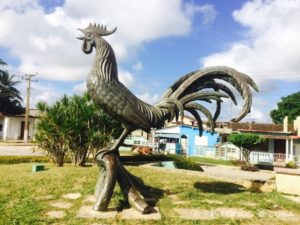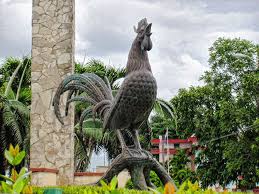HE REMAINED LIKE THE MORÓN ROOSTER, WITHOUT FEATHER AND CUCKING…
Through the generations, the legend of the rooster of Morón has been transmitted, a story that dates back to the 16th century.
He tells that a tax collector from Granada came to the town of Morón de la Frontera, a Spanish municipality in the province of Seville, in the autonomous community of Andalusia, who did not have the liking of its inhabitants not only because of his trade but because of his arrogance, so it was nicknamed “the rooster of Morón.” The locals, tired of his boasting, after beating him up, stripped him naked and expelled him from the village. The story gave rise to a saying, very popular in Andalusia and in numerous flamenco songs: “You are going to stay like the Morón rooster without feathers and cackling on the best occasion”…
Since the 18th century, the tradition of the rooster moved to the city of Morón of the same name, in the current province of Ciego de Avila, as there is a strong population center of Spanish origin in this territory. From the first generations of Moronenses, the rooster became a symbol of the town, although the tradition evolved because it was a rooster with feathers, thus differentiating itself from its nostalgic grandfather from Andalusia. That is why Morón began to be known, first as the “Land of the Rooster” and later as the “City of the Rooster”.
https://youtu.be/uZUg0mR8YIg
THE SONERO PIO LEIVA SINGS “EL GALLO DE MORON”…
In the months after the Triumph of the Cuban Revolution, an officer of the Rebel Army, stationed in this city, to vent his personal frustrations of power, took as a pretext the participation that the tyranny had had the laying of the rooster, and in the early morning of February 6, 1960, accompanied by other people, tore off the monument, depositing it on the public highway in front of the Municipal City Hall. The next day a large group of villagers took the symbol and placed it back on its pedestal, organizing a huge protest demonstration. As a consequence of what happened previously, and due to the political immaturity that existed then, the symbol of the Rooster was identified by some as representative of the odious dictatorship, for which a group of people residing in neighboring towns and urged by some confused and resentful Moronenses, they demolished it again, this time destroying it so that the people could not put it back in its place.
But Morón, from Cuba, is not only famous for the Rooster but also for the Morón torticas, which Mrs. Serafina Echemendía invented, a very distant descendant of that Andalusian, when it occurred to him to take away, for not having, the little of ground peanuts or almonds that had the formula and replace it with grated lemon peel. Wherever there is a Cuban, mantecadas, polvorones (in their more Spanish denominations) or torticas de Morón are common, sweet that some classify as miserable, but that I have only eaten with that flavor in Cuba and in second Cuba, that is Miami.
SE QUEDÓ COMO EL GALLO DE MORÓN, SIN PLUMA Y CACAREANDO…
A través de las generaciones se ha venido transmitiendo la leyenda del gallo de Morón, una historia que se remonta al siglo XVI.
Cuenta que llegó al pueblo de Morón de la Frontera, municipio español de la provincia de Sevilla, en la comunidad autónoma de Andalucía, un recaudador de impuestos de Granada que no contaba con el agrado de sus habitantes no solo por su oficio sino por su soberbia, por lo que fue apodado como «el gallo de Morón». Los locales, cansados de su fanfarronería, después de propinarle una paliza, lo desnudaron y lo expulsaron de la villa. La historia dio lugar a un dicho, muy popular en Andalucía y en numerosas canciones de flamenco: “Te vas a quedar como el gallo de Morón sin plumas y cacareando en la mejor ocasión”..
Desde el Siglo XVIII la tradición del gallo se trasladó a la ciudad de Morón de igual nombre, en la actual provincia de Ciego de Avila, por existir en este territorio un fuerte núcleo poblacional de origen español. Desde las primeras generaciones de moronenses, el gallo se convirtió en un símbolo del pueblo, aunque la tradición evolucionó porque este era un gallo con plumas, diferenciándose así de su abuelo nostálgico de Andalucía. Es por ello que Morón comenzó a conocerse, primero como la “Tierra del Gallo” y después como la “Ciudad del Gallo”.
En los meses posteriores al Triunfo de la Revolución Cubana, un oficial del Ejército Rebelde, destacado en esta ciudad, para desahogar sus frustraciones personales de poder, tomó como pretexto la participación que había tenido la tiranía la colocación del gallo, y en la madrugada del 6 de febrero de 1960, acompañado de otras personas, arrancó el monumento, depositándolo en la vía pública frente al Ayuntamiento Municipal. Al siguiente día un numerosos grupo de pobladores tomaron el símbolo y lo colocaron nuevamente en su pedestal, organizándose una enorme manifestación de protesta. Como consecuencia de lo ocurrido anteriormente, y debido a la inmadurez política existente entonces, se identificó por algunos el símbolo del Gallo como representativo de la odiosa dictadura, por lo que un grupo de personas residentes en poblados aledaños e instados por algunos moronenses confundidos y resentidos, lo derribaron nuevamente, esta vez destruyéndolo para que el pueblo no lo pudiera volver a colocar en su sitio.
Y para no variar, existe la canción del sonero Pio Leyva que dice:
https://youtu.be/j1Gp67NDdbQ
PIO LEIVA CANTA EL GALLO DE MORON.
Pero Morón, el de Cuba, no es famoso solamente por el Gallo sino también por las torticas de Morón, las que inventó la señora Serafina Echemendía, descendiente muy lejana de aquel andaluz, cuando se le ocurrió quitarle, por no haber, el poco de cacahuetes o almendras molidas que llevaba la fórmula y sustuirlo por cáscara de limón rallado. Dondequiera que haya un cubano, son habituales las mantecadas, polvorones (en sus denominaciones más españolas) o torticas de Morón, dulce que algunos catalogan de miserable, pero que solamente lo he comido con ese sabor en Cuba y en la segunda Cuba, o sea Miami.
Agencies/ MemoriasCubanas/ Carlos RodriguezB./ Internet Photos/ YouTube/ Arnoldo Varona/ www.TheCubanHistory.com
THE CUBAN HISTORY, HOLLYWOOD.







